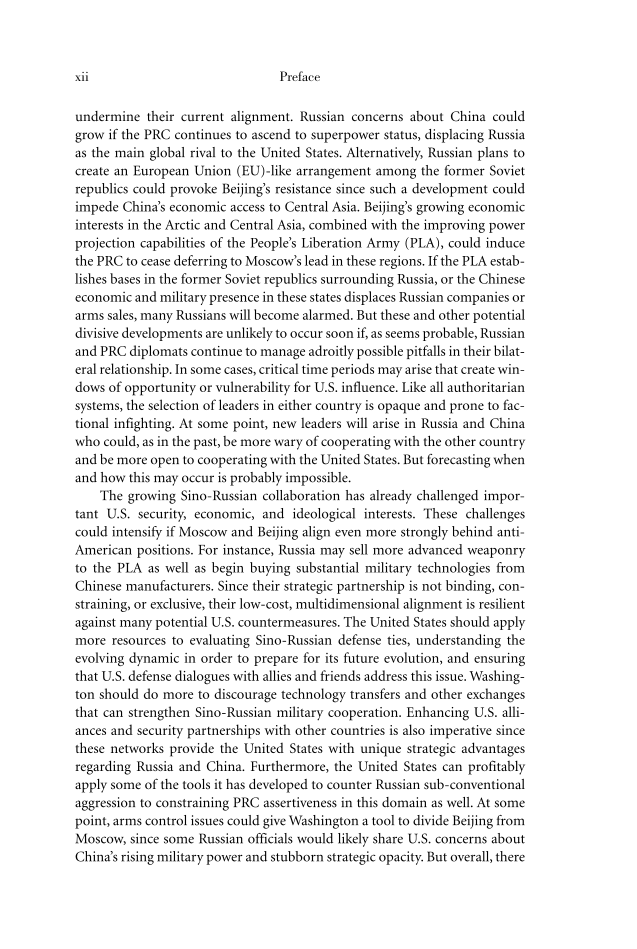xii Preface undermine their current alignment. Russian concerns about China could grow if the PRC continues to ascend to superpower status, displacing Russia as the main global rival to the United States. Alternatively, Russian plans to create an European Union (EU)-like arrangement among the former Soviet republics could provoke Beijing’s resistance since such a development could impede China’s economic access to Central Asia. Beijing’s growing economic interests in the Arctic and Central Asia, combined with the improving power projection capabilities of the People’s Liberation Army (PLA), could induce the PRC to cease deferring to Moscow’s lead in these regions. If the PLA estab- lishes bases in the former Soviet republics surrounding Russia, or the Chinese economic and military presence in these states displaces Russian companies or arms sales, many Russians will become alarmed. But these and other potential divisive developments are unlikely to occur soon if, as seems probable, Russian and PRC diplomats continue to manage adroitly possible pitfalls in their bilat- eral relationship. In some cases, critical time periods may arise that create win- dows of opportunity or vulnerability for U.S. influence. Like all authoritarian systems, the selection of leaders in either country is opaque and prone to fac- tional infighting. At some point, new leaders will arise in Russia and China who could, as in the past, be more wary of cooperating with the other country and be more open to cooperating with the United States. But forecasting when and how this may occur is probably impossible. The growing Sino-Russian collaboration has already challenged impor- tant U.S. security, economic, and ideological interests. These challenges could intensify if Moscow and Beijing align even more strongly behind anti- American positions. For instance, Russia may sell more advanced weaponry to the PLA as well as begin buying substantial military technologies from Chinese manufacturers. Since their strategic partnership is not binding, con- straining, or exclusive, their low-cost, multidimensional alignment is resilient against many potential U.S. countermeasures. The United States should apply more resources to evaluating Sino-Russian defense ties, understanding the evolving dynamic in order to prepare for its future evolution, and ensuring that U.S. defense dialogues with allies and friends address this issue. Washing- ton should do more to discourage technology transfers and other exchanges that can strengthen Sino-Russian military cooperation. Enhancing U.S. alli- ances and security partnerships with other countries is also imperative since these networks provide the United States with unique strategic advantages regarding Russia and China. Furthermore, the United States can profitably apply some of the tools it has developed to counter Russian sub-conventional aggression to constraining PRC assertiveness in this domain as well. At some point, arms control issues could give Washington a tool to divide Beijing from Moscow, since some Russian officials would likely share U.S. concerns about China’s rising military power and stubborn strategic opacity. But overall, there
Document Details My Account Print multiple pages
Print
You have printed 0 times in the last 24 hours.
Your print count will reset on at .
You may print 0 more time(s) before then.
You may print a maximum of 0 pages at a time.

























































































































































































































































































